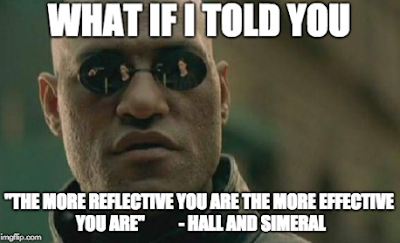Week 19: Contribution of Teacher Inquiry Topics to my Communities of Practice
I will be using Jay and Johnson’s reflective model to reflect on this week.
Description: This weeks reflection is based on 2 topics from the Leadership in Digital and Collaborative Learning course - 1) Innovative learning spaces and 2) Teacher inquiry into student learning. How do these contribute to my Communities of Practice? Firstly I need to understand who my CoP is. Etienne Wenger (1999) states that “Communities of practice are groups of people who share a concern or a passion for something they do and learn how to do it better as they interact regularly.” So in keeping with this view I would assume my CoP is initially my team at Northcote school as they is who my research will affect first, then the rest of the school and if successful possibly my cluster of learning (CoL) schools. It could even involve my mindlab group and as I seem to be on the road to sharing thoughts and practice theories with them already so it may well be them before my CoL.
I have begun to use innovative learning spaces in my single cell environment as our school are on the path to designing our refurbished environments and I need to know what would work for us. My initial feelings are why would anyone want to listen to me, I am no expert I am just trialing something I think would be good practice and seems to be working in my environment with my particular students and community. I am reluctant to start conversations and reflective discussions because of this.
Comparative: It is my understanding that the Ministry are pushing for all schools to move into the 21st Century way of learning and teaching hence the new NZ Technology Curriculum (2017) encompassing “computational thinking for digital technologies” and “designing and developing digital outcomes”. If this is the way of the future then we need to change our learning spaces to meet these needs. Many schools have already changed their learning spaces to meet these needs. Some are working well and some not so much. The ones who are working well have not only changed their learning spaces but also their pedagogy so they both fit together like pieces of a puzzle. The ones that aren’t working so well have not successfully implemented one of those 2 aspects. They have the learning spaces because they had to at that time but they don’t have the innovative pedagogy as they didn’t have the chance to research this before they got the spaces. My school is at the stage where we can start to experiment and research innovative learning styles and theories so we can best design the learning spaces we need to meet the needs of our particular community.
Critical Reflection: We are using the spiral of inquiry theory to reflect on how well our research is going. We have 2 teachers sharing their environments and we reflect on how this is going verbally and where necessary to amend our practice and make changes to suit the needs of our children. We meet once a week to write our reflections down and brainstorm what we can do to improve our practice. Once a month we feed this back to our team to get other ideas of what we can do as well.
References:
Bozarth, J. (2017). Nuts and Bolts: Communities of Practice. Retrieved from https://www.learningsolutionsmag.com/articles/2400/nuts-and-bolts-communities-of-practice
Wenger, Etienne. Communities of Practice: Learning, Meaning, and Identity. Cambridge, UK: Cambridge University Press, 1999.
http://nzcurriculum.tki.org.nz/The-New-Zealand-Curriculum/Technology



Comments
Post a Comment